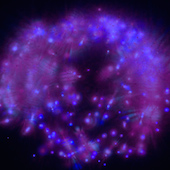Spaceborne Laser Filamentation

This project studied femtosecond laser filamentation from orbital altitudes. In particular, a theoretical and numerical model of the downward vertical propagation of intense femtosecond laser pulses launched from an orbital altitude of 400km was developed. The project's goal was to gain insights on the impact of initial parameters on the filament formation.
Introduction
Laser filamentation, resulting from the nonlinear propagation of intense ultrashort laser pulses in the atmosphere, has become a promising tool in various fields such as the remote sensing of pollutants using Lidar technology, wireless power transmission, electric field mapping of thunderstorms, and propulsion [1-2].
In this technique, femtosecond laser pulses in the terawatt optical power range propagate in the atmosphere behaving as quasi-solitons thanks to a dynamic competition between the optical Kerr effect focusing the beam and the induced plasma effect defocusing the beam. This results in the formation of thin filaments where efficient nonlinear phenomena take place, including self-phase modulation leading to the generation of a coherent broadband continuum spanning,from 300 nm to 14 μm [3].
This phenomenon could be of interest for Lidar systems. The white-light continuum generated from femtosecond filamentation can provide additional information about water vapour and temperature profiles, enabling the direct measurement of relative humidity, and can simultaneously acquire multispectral Lidar information using a single laser source. Ground-based white-light lidar has been demonstrated recently by firing TW laser pulses in the atmosphere and measuring the backscattered white-light using a telescope and a few detectors and spectrometers [4-6]. Furthermore, laser filamentation can also deliver strong optical intensities at kilometric distances in a self-focused optical beam and can guide microwave radiation along induced-plasma channels for wireless power transmission applications [7].
The project
This project studied the remote generation of laser filamentation in the lower atmosphere from orbital altitudes. In this activity the state-of-the-art theory on self-focusing, filamentation and collapse has been extended to long-distance propagation of ultrashort laser pulses in a stratified atmosphere. The model consists of a unidirectional propagation equation with a medium's response model and includes diffraction laws, optical Kerr effect, plasma defocusing, multispecies ionisation and multiphoton absorption. Propagation in the stratified atmosphere was taken into account via an air density profile depending on the molecule type and altitude profile. Supercontinuum generation was studied by adding the temporal dimension to the simulations, accounting for group velocity dispersion in air and the resulting spectral broadening.
This work has not only demonstrated for the first time that via an extension of state-of-the-art models, the remote generation of laser filamentation was possible from orbital altitudes; it also showed that the general parameters (e.g. power level, mass, size) of such a space system would be within the reach of current technological capabilities, thus opening the field for a range of novel applications. It would e.g. lead to a better retrieval of cloud and aerosol size distributions or a simultaneous retrieval of various trace gas profiles using a single laser source, with the added benefit of robust propagation through adverse atmospheric conditions.
This project was conducted in the framework of the Ariadna Project together with researchers from Ecole Polytechnique in Palaiseau, France.
References
- A. Couairon, A. Mysyrowicz, "Femtosecond filamentation in transparent media", Phys Rep. 441, 47-189 (2007).
- S. L. Chin, et al, "Advanced in intense femtosecond laser filamentation in air", Laser Phys. 22, 1 (2012).
- J. Kasparian and J.P. Wolf, "Ultrafast laser spectroscopy and control of atmospheric aerosols", Phys. Chem. Chem. Phys. 14, 9291-9300 (2012).
- J. Kasparian, et al, "White-light filaments for atmospheric analysis”, Science 301, 61-61 (2003).
- M. Rodriguez, et al., R. Sauerbrey, L. Wöste, J.P. Wolf, "Kilometer-range nonlinear propagation of femtosecond laser pulses", Phys Rev E 69, 036607(2004).
- P. Béjot, et al, "32 TW atmospheric white-light laser", Appl. Phys. Lett. 90, 151106 (2007).
- M. Châteauneuf, et al, "Microwave guiding in air by a cylindrical filament array waveguide", Appl. Phys. Lett. 92, 091104 (2008).